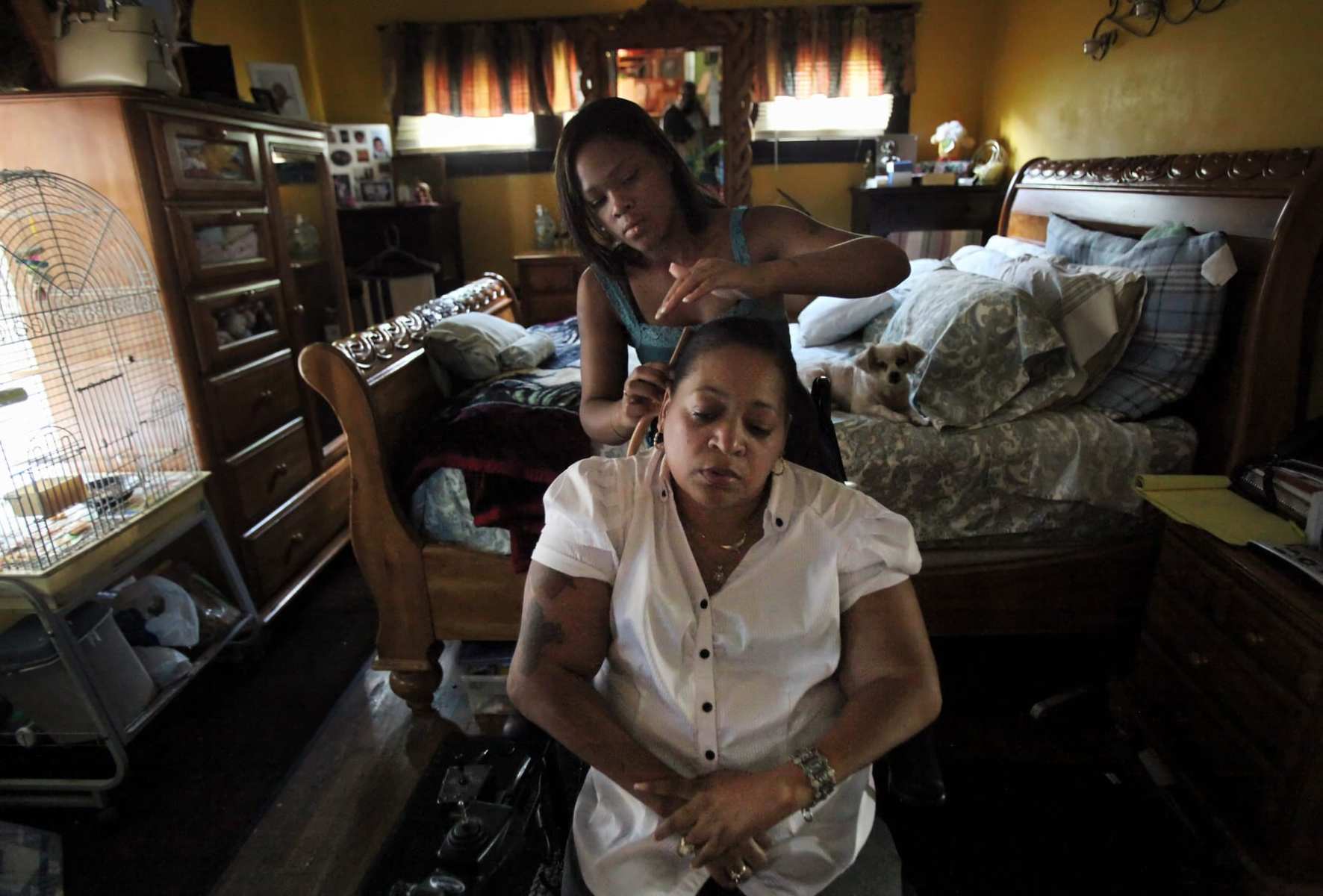In Adarra Benjamin’s family, care work has been generational. It has been passed on from woman to woman — her great-grandmother first, then her grandmother and her mother. In 2012, it was Benjamin’s turn.
She was getting ready to leave for college, planning to study psychology, when her great-grandmother’s dementia worsened. Benjamin postponed her plans, and instead became a full-time caregiver to her great-grandmother, Earsie Williams, and a network of seniors and children with disabilities across Chicago.
It’s grueling work. Some days begin at 8 a.m., with a client who relies on Benjamin to bathe, dress and feed her. The work can end close to 1 a.m. at the home of a different person, who relies on Benjamin to buy groceries, clean the house and prepare meals.
For nearly 100 years, the work that Benjamin and her family has done has taken place in the shadows of the regular labor market, without access to benefits, overtime pay or a guarantee of a minimum wage. It was born of racist and sexist policies that have limited opportunities for advancement for a caregiving workforce that is still 90 percent women, nearly 70 percent people of color and largely immigrants who are paid some of the lowest wages in the country — a median hourly wage of $12.60 in 2020.
President Joe Biden’s administration has vowed to change that, proposing the first multi-billion investment in home care in the nation’s history: $400 billion to expand Medicaid payments to home and community health, nearly doubling the current annual allotment. The money is included as part of Biden’s more than $2 trillion American Jobs Plan, also known as the president’s infrastructure bill.
It comes amid a global health crisis that has illuminated the hardships workers like Benjamin have experienced, going into homes without the necessary protection to care for the most vulnerable in a pandemic that was disproportionately claiming the lives of seniors.
The help was overdue even before COVID-19, Benjamin said.
“The work that we’ve been doing even through this pandemic, it’s been happening. The nurses and doctors and the [certified nursing assistants] and the home care workers being there for you day in and day out is something that’s always been done,” said Benjamin, 27. “I’m really upset that it took this long and it took something so drastic to happen, so many lives to be lost and so much sorrow being created.”
The American Jobs Plan proposal to address home health care arguably goes further than previous administrations to begin the work of investing in long-term care and its workforce. But how Biden intends to do that is not entirely clear.
Details of the plan are still scant, and passage is no guarantee. Many Republicans oppose including care support as “infrastructure,” arguing it’s been shoehorned into a plan that should focus on roads and bridges.
Advocates, though, see an opening to change a narrative that hasn’t shifted in a century, and place home care work, which employs more than 2 million people and has been particularly harmed by the coronavirus crisis, on par with other work that helps the economy move.
The proposal is expected to include many of the details Biden outlined during last summer’s presidential campaign, said Mary Kay Henry, president of the Service Employees International Union, the largest union representing home care workers, which has played a central role in crafting the plan.
That includes expanding the home health aide and community health workforce by another 1.5 million jobs over a decade and strengthening existing jobs with increased pay, federally-provided paid family and medical leave, collective bargaining rights and job training programs.
“This is all explicit in the conversations we’ve been having with the White House, Senate and House,” Henry said. “And it’s a way to put women of color who have borne the brunt of the crisis on multiple fronts — racial, economic, public health and climate — at the center of our recovery, and so we really see it as a once-in-a-generation opportunity to make home care jobs the good union living wage jobs of the future.”
Recent changes in federal law have folded home care workers into minimum wage and overtime requirements. State-by-state battles have allowed some workers to obtain a broader set of benefits. But many still lack their own health insurance and paid leave.
About a quarter of home health aides are uninsured, and more than a third rely on Medicaid or Medicare coverage, according to a study by PHI, a New York-based advocacy group that studies home care workers and is frequently cited as an authority on the topic. A quarter live in households below the federal poverty line, and about half rely on public assistance.
“[Home health aides] exist largely outside of the formal labor force, and that’s something that’s gone back for generations,” said Tina Tchen, president and CEO of Time’s Up, which works to combat gender-based workplace discrimination. “It was viewed as you’re just paying for a companion, so therefore it’s not really a real job, or not really a job we should pay for because it’s been free labor in the past.”
These struggles date back decades. In the 1930s, agricultural and domestic workers were excluded from labor protections including minimum wage, collective bargaining rights and overtime pay at the insistence of Southern Democrats who wanted to pay that workforce — many of them former slaves — little to nothing. When the Fair Labor Standards Act was passed in the 1970s, home care aides were shut out through a “companionship” exemption in the law — minimum wage laws and overtime protections weren’t meant to cover people who were companions to others in the home or employed through a third party. The Occupational Safety and Health Act, passed in 1970, didn’t extend workplace protections to home health workers, either.
Former President Barack Obama’s administration worked to eliminate some of those loopholes by signing an executive order that specified that workers who help their clients perform tasks like bathing and cleaning should get the same protections. But it didn’t increase funding, and so some workers saw their hours reduced.
[Home health aides] exist largely outside of the formal labor force, and that’s something that’s gone back for generations.
Tina Tchen, president and CEO of Time’s Up
Meanwhile, demand for home care is only ballooning. Researchers say that while $400 billion represents an unprecedented, potentially transformative investment, the issue will require continued attention, especially as more Baby Boomers age into needing care and increased desire to age at home — rather than nursing homes — means more Americans in general are opting for home-based services.
“This is an amazing investment, but we also need to think about sustainable improvement,” said Kezia Scales, the director of policy research at PHI. “We need to continue to be thinking about how our system might need to be transformed to really address the deep-rooted challenges we have.”
Home care is also one of the fastest growing workforces in the country. Between 2019 and 2029, the Bureau of Labor Statistics estimated that the profession is set to grow 34 percent — the average for all jobs is 4 percent. It’s a draw for immigrant women, and particularly older immigrant women who have cared for loved ones and then can transition into home health, said William Dombi, the president of the National Association for Home Care & Hospice, the trade organization that represents agencies.
“The question is, will 1.5 million [new jobs] be enough for what we are going to see?” Dombi said.
If jobs don’t keep pace with demand, cost will go up, limiting access to home care even further. But just because home care gets more expensive, that doesn’t mean workers’ wages will increase.
“We don’t want to see health care at home become the bastion of wealthy people,” many of them White, being cared for by low-wage women of color, Dombi said. “You’re looking at a plantation back in the 1800s at that stage.”
The wealth divide is already impacting home care workers. Most people don’t have enough money to pay for full-time home care, so they rely on Medicaid, the public insurance program for low-income people, and Medicare, which covers people who are older or who have disabilities.
But Medicaid in particular has long been underfunded when it comes to insuring all the people seeking home-based care, said Molly Kinder, a fellow at the Brookings Institution. That means long wait lists — more than 700,000 people were on the Medicaid waitlist for home care as of 2017 — and systematically low wages for the workers.
“We simply are not allocating the funding for this kind of service,” she said.
The concern has only grown in the pandemic, she said. As nursing homes emerged as coronavirus hotbeds, more Americans have moved instead to keep their loved ones at home, with an at-home aide, stretching wait times even longer. But additional funding hasn’t followed.
Meanwhile, Medicaid is run by individual state governments, which determine what home care providers — workers and the companies employing care workers — actually make per each service. Insufficient federal home care investment has kept those payment rates low, experts said. That, combined with historic disregard for home care, has made it difficult for care workers to actually earn a living wage.
“You can’t pay someone $15 an hour if you get $15 an hour, because there are costs that are in addition to compensation,” Dombi said. “What you’ve got is a starting point that really puts the worker and the employer behind the eight ball.”
That has implications for workers — who are often their family’s main breadwinners — and for people receiving home care. Low wages, no path for professional advancement, and lack of benefits are all major reasons people leave the home care workforce. And low public investment means that families on Medicaid aren’t able to get as many hours of care as they might need.
“Unlike anything else maybe you see in health care — the hourly wages translate into what the care is,” said Tara McGuinness, a fellow at New America, a Washington, D.C., think tank, who also worked on the Biden transition team.
While the Biden plan makes inroads, advocates and home care researchers argue that it’s a down payment, and leaves other needs still unaddressed. Even with billions in federal funding, states will likely have considerable discretion to determine how home care programs work and what workers are paid.
“The role of states will be really important,” Kinder said. “There’s a lot of important questions still.”
Without bipartisan support, the package is looking at going down the road of reconciliation — a Senate rule allows bills to pass with 50 votes, rather than the 60 typically needed, if the contents of the legislation are tied to the budget. Biden has said he is open to going that route if he can’t get 10 Republicans in the Senate to support the measure, meaning it will likely pass in the way the first stimulus package did — without a single Republican vote.
Recent polling shows strong support for the caregiving piece of the proposal. A recent Morning Consult-Politico poll put support at 76 percent, including 64 percent of Republican voters. That’s consistent with past polling that has found that the majority of Americans support investments in home care.
“Having that opportunity, which we’ve never had with any administration thus far, has me happy,” Benjamin, the home care worker, said, “[but] with a sense of urgency to see how fast we can get it done.”






